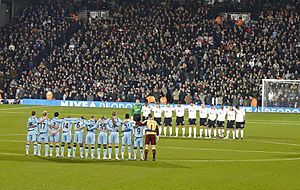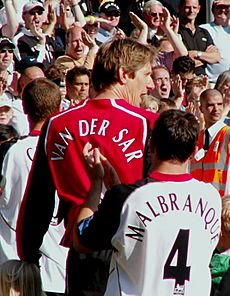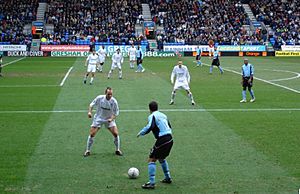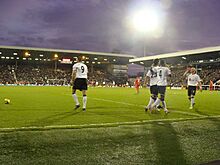History of Fulham F.C. facts for kids
Fulham Football Club is a professional football team from West London, England. Its story began in 1879.
Contents
- Early Days: Fulham's Start (1879-1898)
- Becoming Professional: Southern League Years (1898-1907)
- Joining the Football League (1907-1949)
- Reaching the Top Flight (1949-1970)
- Moving Between Divisions (1970-1994)
- Rising from the Fourth Tier (1994-1997)
- Al Fayed's Revolution (1997-2001)
- Premier League Years (2001-2007)
- Roy Hodgson Years (2007-2010)
- Recent Years: Ups and Downs (2010-Present)
Early Days: Fulham's Start (1879-1898)
Fulham Football Club began in 1879. It was first called St Andrew's Cricket & Football Club. This club was started by people from St. Andrew's Church, Fulham in West Kensington. The church still has a plaque remembering the team's beginning.
The team won the West London Cup in 1887. In 1888, they changed their name to Fulham. They then won the West London League in 1893 on their first try. Fulham's first ever uniform had dark and light blue shirts with white shorts. The club started playing at their home ground, Craven Cottage, in 1896. Their first game there was against Minerva F.C., a team that no longer exists.
Becoming Professional: Southern League Years (1898-1907)
| Years | League |
|---|---|
| 1898-03 | Southern League Division 2 |
| 1903-07 | Southern League Division 1 |
Fulham became a professional football club on December 12, 1898. In the same year, they joined the Southern League's 2nd division. Back then, their uniform looked a lot like what Arsenal wears today.
In the 1902–03 season, Fulham won promotion from the 2nd division. They moved up to the Southern League 1st Division. The club first wore a white uniform in 1903. Since then, they have played in white shirts and black shorts. Their socks have changed over time, but are usually white now. Fulham won the Southern League championship twice, in 1905–06 and 1906–07.
Joining the Football League (1907-1949)
| 1907–28 | Football League Div. 2 | (Level 2) |
|---|---|---|
| 1928–32 | Football League Div. 3S | (Level 3) |
| 1932–49 | Football League Div. 2 | (Level 2) |
After winning the Southern League twice, Fulham joined the national Football League. Their first league game was in the 2nd Division in the 1907-8 season. They lost 1–0 at home to Hull City on September 3, 1907. Their first win came a few days later, on September 7, 1907. They beat Derby County 1–0.
Fulham played well in their first season, finishing only three points short of promotion. However, this was their best season in the 2nd Division for 21 years. In the 1927–28 season, they won only 13 out of 42 games. This meant Fulham was moved down to the 3rd Division South. This division was created in 1920.
A big moment in that first season was an 8–3 away win against Luton Town in an FA Cup game. The club even reached the semi-finals of the FA Cup. But they lost badly, 6–0, to Newcastle United. This is still a record loss for an FA Cup semi-final. A few years later, Fulham won the London Challenge Cup in the 1909–10 season.
During this time, Henry Norris was the club chairman. He also played a part in starting Fulham's local rivals, Chelsea. Norris turned down an offer to move Fulham to the land where Chelsea's stadium, Stamford Bridge, now stands. So, the businessman Gus Mears decided to create his own team, Chelsea, to play there. In 1910, Norris also became chairman of Arsenal.
After finishing 5th, 7th, and 9th in their first three seasons in the 3rd Division South, Fulham won the division in the 1931–32 season. They beat Torquay United 10–2, won 24 out of 42 games, and scored 111 goals. This earned them promotion back to the Second Division. The next season, they almost got promoted again, finishing third.
The club also reached another FA Cup semi-final in the 1935–36 season. On October 8, 1938, Craven Cottage had its biggest ever crowd. 49,335 fans watched a game against Millwall. Football was stopped for a while when World War II started in 1939. Full league games returned in 1946–47. In the third season after the war, Fulham finished first in the Second Division. They won 24 games, lost 9, and drew 9.
Reaching the Top Flight (1949-1970)
| 1949–52 | Football League Div. 1 | (Level 1) |
|---|---|---|
| 1952–59 | Football League Div. 2 | (Level 2) |
| 1959–68 | Football League Div. 1 | (Level 1) |
| 1968-69 | Football League Div. 2 | (Level 2) |
When Fulham moved up to the top league in English football, they struggled. They finished 17th in their first year and 18th in their second. In their third season in the First Division, Fulham finished last in the 1951–52 season. They won only 8 out of 42 games. On May 20, 1951, Fulham played one of their first games in North America. It was an exhibition match against Celtic in Montreal.
After a few average seasons in the 2nd Division, Fulham reached the FA Cup semi-finals in 1958. They used this success to get promoted back to the 1st Division the next season. They finished second behind Sheffield Wednesday. In 1958, Graham Leggat joined Fulham. He scored 134 goals in 277 games, making him the club's fifth highest scorer ever. In the 1959–60 season, Fulham finished tenth in the 1st Division. This was their highest league position until they finished ninth in 2003–04 FA Premier League. They also reached the FA Cup semi-finals again in 1962.
By this time, Fulham regularly played in front of over 30,000 fans at Craven Cottage. The club had several close calls with relegation. One of the most amazing was in 1965–66. On February 26, 1966, Fulham had only 15 points from 29 matches. But in their last 13 games, Fulham won nine and drew two to stay safe.
Eventually, the club was relegated in the 1967–68 season. They won only 10 out of 42 games. The next season was even worse. They won only 7 out of 42 games and were relegated again to the 3rd Division. This was a different 3rd Division than before, as the regional divisions were removed in 1959.
It's important to talk about Johnny Haynes, probably the most important person in Fulham's history. He was known as "Mr. Fulham" or "The Maestro". He joined Fulham as a schoolboy in 1950. His first team game was on Boxing Day 1952 against Southampton. Haynes played for 18 more years, making 657 appearances. He is often seen as Fulham's greatest player and never played for another British team. He played 56 games for England, captaining them 22 times. Many of these games were while he played for Fulham in the Second Division. Haynes was hurt in a car crash in 1962. He later said he never got back to full fitness for England. He missed out on England winning the 1966 FIFA World Cup. The Stevenage Road Stand at Craven Cottage was renamed in his honor after he died in a car crash in 2005.
Moving Between Divisions (1970-1994)
Fulham's time in the 3rd Division lasted only two seasons. They were promoted back to the Second Division in 1970–71. During this period, Fulham was invited to the Anglo-Italian Cup. They drew all four of their games in 1973.
Under manager Alec Stock in the mid-1970s, Fulham signed famous players like Alan Mullery and Bobby Moore. This led to their only FA Cup final appearance in 1975. They won their first semi-final after five tries. However, they lost to West Ham United in the final. This allowed them to play in another European tournament, the Anglo-Scottish Cup. They reached the final but lost to Middlesbrough.
That FA Cup run set a record for the most games needed to reach the final. Fulham played 11 games, including replays. Before the final, the team released a song called "Viva el Fulham". It is still played at Fulham games today.
| 1969–71 | Football League Div. 3 | (Level 3) |
|---|---|---|
| 1971–80 | Football League Div. 2 | (Level 2) |
| 1980–82 | Football League Div. 3 | (Level 3) |
| 1982–86 | Football League Div. 2 | (Level 2) |
| 1986–94 | Football League Div. 3/2 | (Level 3) |
Famous player George Best played 47 times for the club in the 1976–77 season. Rodney Marsh, who grew up with Fulham, also rejoined the club that season. This was one of Fulham's most successful times.
After this, the club was relegated again in the 1979–80 season. Manager Bobby Campbell was replaced by Malcolm Macdonald in October 1980. With a strong team, they won promotion again in 1981–82 back to Division 2. In 1980, Fulham started a rugby league club, now called Harlequins RL. It was meant to bring in more money for the football club.
Fulham almost got promoted to the First Division two years in a row. But they lost 1–0 to Derby County on the last day of the 1982–83 season. The match was stopped early because fans ran onto the field. The promising team was slowly sold off because the club had debts. So, it was not a surprise when they were relegated to the Third Division in 1986.
The club almost went out of business in 1987. This was due to a bad attempt to merge with Queens Park Rangers. But the Football League and a group led by former player Jimmy Hill helped the club stay open. In the same year, Fulham played in the longest penalty shootout recorded at that time. It took 28 penalty kicks to decide a winner.
In 1992, the Premier League was formed. The top division teams left the Football League. This meant Fulham was moved up to the 2nd Division. However, the club was relegated to the new 3rd Division after a poor 1993–94 season. After this, Ian Branfoot became manager.
Rising from the Fourth Tier (1994-1997)
| 1994–97 | Football League Div. 3 | (Level 4) |
|---|
After finishing eighth in Branfoot's first season, the club reached its lowest position since the early 1900s. In the 1995–96 season, they finished 17th out of 24 teams. This season included a loss to Torquay United, who were last in the division. Branfoot was soon fired as manager.
In February 1996, player Micky Adams became manager. That summer, his changes really began. This marked the start of a new era for Fulham. Adams helped the team improve and avoid relegation. The next season, his team, led by captain Simon Morgan, finished second. They only missed out on first place because the league changed how tied positions were decided. Fulham's chairman, Jimmy Hill, had actually argued for this change.
Al Fayed's Revolution (1997-2001)
| 1997–99 | Football League Div. 2 | (Level 3) |
|---|---|---|
| 1999–01 | Football League Div. 1 | (Level 2) |
| 2001– | Premier League | (Level 1) |
Millionaire Mohamed Al-Fayed bought the club that summer. He fired Adams and brought in Ray Wilkins as first team manager and Kevin Keegan as chief operating officer. Al-Fayed promised the club would reach the Premier League within five years.
After a disagreement, Wilkins left in May 1998. Keegan took over as full manager. He led the club to an amazing promotion the next season, earning 101 points. They spent £1.1 million to sign Paul Peschisolido. Keegan then left to manage the England national team. Veteran player Paul Bracewell was put in charge.
Bracewell was fired in March 2000. Fulham's good start to the season had faded. Frenchman Jean Tigana took over. With only two new players, including French striker Louis Saha, he guided Fulham to their third promotion in five seasons. This was in the 2000–01 season. They scored 90 goals in 46 games. This brought Fulham back to the top league for the first time since 1968. It took only four years, one year less than Al Fayed's promise.
During this season, club captain Chris Coleman was in a car crash. He was out of action for over a year and his playing career ended. Sean Davis was the only player to play for Fulham in all four leagues during this time.
Premier League Years (2001-2007)
Many people thought Fulham would do very well in the Premier League. Some even predicted they would challenge for European spots. But their first Premier League season was not as exciting. They finished 13th, which was still good. Fulham is the only team in this century to host top-flight football with some standing areas for fans. Because of new rules, Fulham played at Loftus Road in the 2002–03 and 2003–04 seasons while Craven Cottage was rebuilt. They then returned home.
The next season, Fulham was dangerously close to being relegated. Chairman Mohammed Al Fayed told Tigana his contract would not be renewed. But after a terrible run of results, Tigana was fired early. Jean Tigana had made the club's most expensive signing, buying Steve Marlet for £11.5 million. He did not play as well as expected.
Chris Coleman took charge for the last five games of that season. He earned Fulham 10 points out of 15. This kept them in the Premier League for the next season. Coleman was given the manager's job permanently in the summer of 2003. Many thought Fulham would be relegated because Coleman was new to managing. But he kept the club safe, guiding them to a club record ninth-place finish in his first season. This could have been even better. But the club had to sell Louis Saha to Manchester United for a club record £13 million. On the last day of the season, they won 2–0 away to Bolton Wanderers.
Coleman had another good season in 2004–05. He guided Fulham to a safe 13th-place finish. The 2005–06 season was harder. But they secured safety with three games left. There were some highlights: a 6–1 win over West Bromwich Albion, a 1–0 win over rivals Chelsea, and a 2–0 win over European champions Liverpool. Fulham's home form was very strong. Their away form was the worst in the league. Despite the difficulties, Fulham finished 12th.
Fulham did not start well in 2006–07, losing 5–1 to Manchester United. This put them at the bottom of the table. But they recovered and were as high as eighth in December 2006. In January, Coleman added new players like Alexey Smertin, Clint Dempsey, and Simon Davies. They also got Vincenzo Montella on loan.
However, between mid-December and May, Fulham won only one game. They drew nine and lost four. They also lost 4–0 to Tottenham Hotspur in the FA Cup. On April 10, 2007, Fulham fired Chris Coleman. Lawrie Sanchez and Les Reed took over temporarily.
Sanchez did not have an immediate impact. With five games left to save the season, Sanchez got only one point from the first three games. In Sanchez's fourth game, Fulham played Liverpool. Liverpool's manager made many changes to his team. But Fulham still faced a strong side. Clint Dempsey scored in the 68th minute, giving Sanchez his first win. This win kept Fulham in the top league. Fulham finished the season with a 3–1 loss to Middlesbrough.
Even though he only got 4 points from 15, Sanchez kept Fulham in the top league. He was rewarded with a permanent contract. Sanchez signed many new players, including striker Diomansy Kamara for £6 million. Most of his new players were from the Northern Ireland team.
Fulham did not show much improvement in the 2007–08 season. They lost 2–1 to Arsenal on the first day. But they beat Bolton Wanderers 2–1 in the next match. Fulham was playing attractive, attacking football. But they were unlucky and had some bad referee decisions. In their third game, captain Brian McBride was seriously injured.
Fulham then had several draws, including two exciting six-goal games. These games showed Fulham's good attacking play but also their poor defending. Sanchez tried a more direct style of play, but his team was not suited for it. He was fired on December 21, 2007, after a loss to Newcastle United. Fulham was in the relegation zone.
Roy Hodgson Years (2007-2010)
Roy Hodgson became Fulham's new manager on December 28, 2007. He started his job on December 30, just before the January transfer window opened. The team got stronger with new players like Brede Hangeland, Leon Andreasen, and Eddie Johnson. Veteran striker Jari Litmanen also joined. Key players Brian McBride and Jimmy Bullard returned from injury. They were very important in Fulham's end-of-season run.
Hodgson's time started with a 2–1 loss to Chelsea. Then came a 0–0 draw with Bolton. His first win was five days later against Aston Villa. Jimmy Bullard scored with a free-kick. Fulham struggled to build momentum. But Hodgson got a second win on March 16, 2008, against Everton. Fulham won 1–0.
However, Fulham again failed to keep winning. A 3–1 home loss to Sunderland left Hodgson very upset. Many experts thought Fulham would be relegated. But Hodgson believed they could survive. He led his team to win four of their last five games. This secured their Premier League spot for the 2008–09 season.
This amazing run started with their first away win in 34 tries, against Reading. For many fans, the turning point was two games later, against Manchester City. Fulham was losing 2–0 at half-time. If the scores stayed the same, Fulham would have been relegated. But Diomansy Kamara came on and scored twice. Fulham won 3–2 in an amazing comeback.
This set up a crucial game against Birmingham City. McBride and Erik Nevland scored, lifting Fulham out of the relegation zone. Survival was now in their own hands.
Fulham needed to beat Portsmouth to guarantee survival. Portsmouth was focused on their FA Cup Final. Fulham had never won three away games in a row. Fulham fans traveled to Fratton Park expecting a tense final day. With 15 minutes left, Fulham would have been relegated. But Kamara won a free-kick. Danny Murphy headed in the winning goal. This sparked huge celebrations. Hodgson had kept Fulham in the league against all odds.
After their escape, Roy Hodgson said Fulham needed to avoid such a situation again. He signed experienced goalkeeper Mark Schwarzer. Captain Brian McBride left to play in the USA. Fulham also signed Andranik Teymourian and Zoltán Gera. In July, Fulham signed Bobby Zamora and John Paintsil from West Ham.
Then came the signing of Andrew Johnson. He joined from Everton for almost £13 million. This made him Fulham's second most expensive signing ever.
Fulham's start to the season was not great, losing 2–1 to Hull City. But two home games saw them beat Arsenal 1–0 and Bolton 2–1. They also beat Leicester City in the League Cup. Four losses in a row made Fulham drop down the table.
Two draws helped stop the losing streak. A 2–0 home win against Wigan was important. Fulham then lost to Everton, but beat Newcastle and Tottenham at Craven Cottage. The win against Spurs was special, as Fulham was the first team to beat Tottenham under their new manager. Two 0–0 draws saw them rise to tenth in the table. They were unbeaten in six matches. After a 3–0 win against Middlesbrough, Fulham had a good Christmas period. They drew 0–0 away to Tottenham and had a dramatic draw at home to Chelsea. Both goals came from Clint Dempsey.
In March 2009, Fulham had mixed results. They lost to Blackburn and Hull City. But they sensationally won 2–0 at Craven Cottage against Premier League champions Manchester United. Two United players were sent off. Danny Murphy and Zoltán Gera scored for Fulham. Earlier in the season, the team reached the FA Cup quarter-finals, losing to Manchester United.
The next season was arguably Fulham's greatest success. They reached the 2009-10 Europa League Final. They lost 2–1 to Atlético Madrid after extra time. The club also finished 12th in the Premier League that season. Because of this, Roy Hodgson was voted the LMA Manager of the Year.
Recent Years: Ups and Downs (2010-Present)
On July 29, 2010, Mark Hughes became Fulham's new manager. He signed a two-year contract. But Hughes resigned after only one season on June 2, 2011. Martin Jol replaced Hughes as manager.
Shahid Khan became chairman in July 2013. Since then, the club has had many managers. Martin Jol was quickly replaced by René Meulensteen. Other managers included Felix Magath, and temporary roles for Kit Symons and Peter Grant. This led to Fulham spending time back in the Championship.
It was not until Khan hired Slaviša Jokanović that Fulham started to improve. He led them back to the Premier League in 2017–18. However, Jokanović was fired in November 2018 after a poor start to the season. Former Leicester manager Claudio Ranieri replaced him. But Ranieri could not turn things around. Coach Scott Parker took over as caretaker manager in February 2019. Parker could not save Fulham, and they were relegated back to the Championship at the end of the 2018–19 season.
In his first full season as manager, Parker led the club straight back to the Premier League. They beat Brentford 2–1 in the 2020 Championship play-off final.
|






